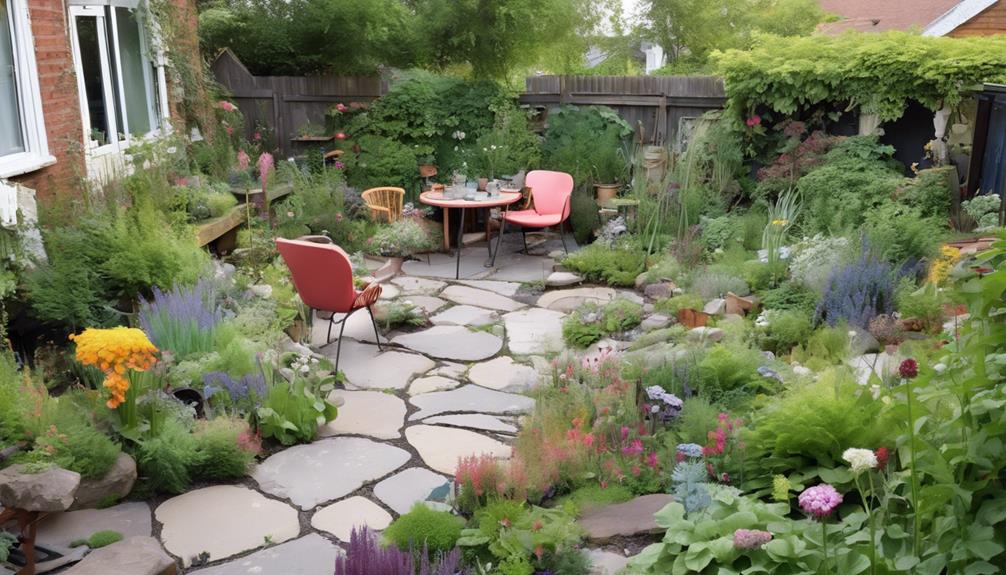
Tree Planting Oldbury
15 February 2025Why Is Pressure Washing Your Garden Fences Essential?
15 February 2025To design unique garden landscapes, it is essential to initially apply crucial design principles such as balance and emphasis for visual appeal.
Select a diverse range of plants, including native species, ensuring they are suitable for your climate and aesthetically harmonious.
Focus on maintaining soil quality through organic amendments and moisture retention techniques.
Incorporate sustainable practices, such as water conservation and organic pest management, to promote biodiversity.
Ultimately, implement creative design elements like vertical gardens or themed areas to enhance functionality and beauty.
For further insights into achieving an extraordinary garden, explore supplementary strategies and ideas.
Garden Design Essentials
Effective garden design hinges on fundamental principles that guide the layout, functionality, and aesthetic appeal of the space.
Choosing the right plants is vital, as their selection impacts not only the visual harmony but also the sustainability and maintenance of the garden.
Understanding these foundational elements is key to creating a successful landscape that serves both beauty and purpose.
Essential Design Principles
There are several significant design principles that serve as the foundation for creating a successful garden landscape. Firstly, balance is fundamental; whether symmetrical or asymmetrical, it ensures visual harmony.
Next, proportion plays an important role in determining the scale of elements relative to one another and the space itself. Emphasis allows for focal points to draw attention, guiding the viewer's eye throughout the design.
Furthermore, rhythm and repetition create a sense of movement and unity within the landscape.
Finally, consider the principles of contrast and harmony; contrasting elements provide interest, while harmonious designs foster tranquillity.
Choosing the Right Plants
Selecting the right plants is crucial for achieving a successful garden landscape that thrives in its environment. A discerning approach involves evaluating climate, soil conditions, and sunlight exposure to ensure ideal plant health.
Native species often provide resilience and ecological harmony, as they are adapted to local conditions and support native wildlife. Furthermore, consider the seasonal dynamics; incorporating a mix of perennials, annuals, and evergreens creates year-round interest and biodiversity.
Aesthetic elements, such as foliage texture, colour, and form, should align with the comprehensive design vision, fostering cohesion. Finally, assess maintenance requirements to ensure sustainable care practices.
Soil Quality and Composition
Soil quality and composition are fundamental to successful garden landscape design, influencing plant health and growth.
Key factors include adjusting pH levels to optimise nutrient availability, incorporating organic matter to improve soil structure and fertility, and using mulch to retain moisture and regulate temperature.
Ph Level Adjustments
Maintaining an ideal pH level in garden soil is crucial for promoting healthy plant growth and ensuring nutrient availability. Soil pH influences the solubility of vital nutrients and the biological activity within the soil.
Regular testing and adjustments can create an optimal environment for a diverse range of plants.
To effectively manage soil pH, consider the following strategies:
- Testing: Utilise reliable soil testing kits to determine the current pH and identify necessary adjustments.
- Amendments: Incorporate lime to raise pH levels or sulphur to lower them, based on specific plant requirements.
- Monitoring: Regularly re-test soil pH to verify it remains within the desired range, allowing for timely interventions as needed.
Organic Matter Incorporation
Incorporating organic matter into garden soil significantly enhances its quality and composition, fostering a thriving ecosystem for plants.
Organic matter improves soil structure, increases nutrient retention, and promotes beneficial microbial activity. This practice not only supports plant health but also contributes to improved water infiltration and retention.
Key benefits of organic matter incorporation include:
- Improved Soil Fertility: Organic matter provides essential nutrients, facilitating optimal plant growth.
- Enhanced Soil Structure: It helps create a crumbly texture, allowing roots to penetrate more effectively.
- Increased Microbial Diversity: A rich microbial community promotes natural pest control and disease resistance.
Mulch for Moisture Retention
Applying mulch effectively can significantly enhance moisture retention in garden beds, contributing to overall soil quality and composition. By creating a protective layer over the soil, mulch minimises evaporation, regulates soil temperature, and suppresses weed growth.
The choice of mulch material can further enhance its benefits, ensuring ideal moisture levels for plant health.
- Organic Mulches: Materials such as wood chips or straw decompose over time, enriching the soil with nutrients.
- Inorganic Mulches: Options like gravel or rubber provide longevity and require minimal maintenance, whilst still preventing moisture loss.
- Colour and Texture: Selecting visually appealing mulches can improve the aesthetic quality of the landscape, integrating functionality with design.
Incorporating mulch not only preserves moisture but also enhances the overall quality of your garden ecosystem.
Designing With Native Plants
Designing with native plants requires a clear understanding of your garden's purpose, whether for aesthetics, wildlife support, or personal enjoyment.
Employing companion planting techniques can enhance biodiversity and promote healthy growth, while vertical gardening strategies can optimise space and create visually striking displays.
Identify Your Garden's Purpose
A well-defined garden purpose serves as the foundation for successful landscape design, particularly when integrating native plants. Understanding your garden's purpose guides plant selection, spatial arrangement, and overall aesthetic, ensuring that your design aligns with ecological goals and personal vision.
Consider these key aspects:
- Ecological Benefits: Native plants support local wildlife, promote biodiversity, and enhance soil health.
- Functional Use: Determine if your garden will serve recreational, educational, or aesthetic purposes, tailoring plant choices accordingly.
- Maintenance Requirements: Assess how much time you can dedicate to upkeep, selecting native species that thrive in your specific environment with minimal intervention.
Companion Planting Techniques
Integrating companion planting techniques into your garden can significantly enhance the benefits of using native plants.
By thoughtfully selecting plant pairings, you can improve biodiversity, promote healthier growth, and deter pests naturally. Native plants, when combined effectively, provide mutual benefits that support a resilient ecosystem.
- Pest Control: Certain native plants repel pests, thereby reducing the need for chemical interventions.
- Nutrient Sharing: Deep-rooted natives can help to bring nutrients to the surface, benefiting shallow-rooted companions.
- Pollinator Attraction: Planting a variety of native species can attract diverse pollinators, promoting cross-pollination and increasing yields.
Utilising these companion planting techniques not only fosters a thriving garden but also aligns with sustainable practices that honour local ecosystems.
Vertical Gardening Strategies
While vertical gardening offers a unique approach to maximising space and enhancing aesthetics, employing native plants in this design can greatly contribute to ecological health.
Native plants are adapted to local climates and soil conditions, requiring less maintenance and water than non-native species. Their integration into vertical gardens supports local wildlife, including pollinators and beneficial insects, fostering a vibrant ecosystem.
Consider these strategies for incorporating native plants into your vertical gardens:
- Select Varieties: Choose native vines, such as clematis or honeysuckle, that thrive in vertical spaces.
- Layering Techniques: Utilise a tiered structure to display a variety of native plants, ensuring biodiversity.
- Soil Health: Implement organic practices to enrich the soil, promoting sustainability and plant vigour.
Increased Biodiversity in Gardens
Many gardeners may overlook the profound impact that increased biodiversity can have on their landscapes. A diverse array of plant species not only enhances visual appeal but also fosters a balanced ecosystem. By incorporating native flora, gardeners can attract beneficial insects, birds, and pollinators, ultimately leading to a thriving environment.
| Plant Type | Benefits | Example Species |
|---|---|---|
| Native Perennials | Supports local wildlife | Echinacea purpurea |
| Flowering Shrubs | Provides shelter and food | Viburnum dentatum |
| Ground Covers | Reduces soil erosion | Thymus serpyllum |
| Trees | Improves shade and habitat | Quercus rubra |
Implementing these diverse elements creates a harmonious balance, ensuring resilience and sustainability within garden landscapes.
Sustainable Pest Management Techniques
Sustainable pest management techniques are crucial for maintaining a healthy garden ecosystem while minimising chemical inputs.
Implementing strategies such as the release of beneficial insects, application of beneficial nematodes, and the use of organic fertilisers can effectively control pests and promote plant health.
These methods not only reduce reliance on synthetic pesticides but also improve biodiversity within the garden landscape.
Beneficial Insect Release Techniques
Incorporating beneficial insect release techniques into garden landscape design allows for a more natural approach to pest management. By strategically introducing beneficial insects, gardeners can enhance their landscapes' ecological balance, leading to healthier plants and a reduced reliance on chemical pesticides.
Key techniques include:
- Targeted Release: Introduce specific beneficial insects, such as ladybirds or lacewings, at optimal times to effectively control pest populations.
- Habitat Improvement: Create environments that attract beneficial insects by incorporating diverse plant species and providing shelter, such as native flowering plants.
- Monitoring and Timing: Regularly observe pest populations and environmental conditions to determine the best timing for releasing beneficial insects, ensuring maximum impact.
Employing these techniques cultivates a thriving ecosystem, promoting sustainable pest management and improving garden health.
Beneficial Nematode Application
Beneficial nematodes offer an effective and environmentally friendly option for managing soil-dwelling pests, complementing the strategies of beneficial insect release.
These microscopic roundworms can be introduced into garden ecosystems to target a variety of pests, such as grubs and root weevils, without harming beneficial organisms. Their application involves meticulous planning and execution to ensure maximum efficacy.
- Targeted Action: Nematodes specifically seek out and infect pest larvae in the soil.
- Ease of Use: They can be applied through irrigation systems or as a soil drench.
- Sustainable Solution: Their natural lifecycle supports long-term pest control while maintaining ecological balance.
Implementing beneficial nematodes not only enhances pest management practices but also promotes a healthier garden environment.
Organic Fertilizer Usage
How can organic fertilisers contribute to effective pest management in garden landscapes? The incorporation of organic fertilisers improves soil health, fostering a robust ecosystem that naturally deters pests.
Healthy plants are more resilient and better equipped to withstand pest pressures. Furthermore, organic fertilisers promote the growth of beneficial microorganisms, which can outcompete harmful pests and pathogens.
- Nutrient-Rich Composition: Organic fertilisers are often rich in vital nutrients, promoting plant vigour and reducing susceptibility to infestations.
- Improved Soil Structure: They enhance soil aeration and water retention, creating a more conducive environment for beneficial insects.
- Natural Repellents: Some organic fertilisers, such as those derived from fish or seaweed, contain compounds that can deter specific pests.
Utilising organic fertilisers is a strategic approach to sustainable pest management.
Pest Resistance Strategies
Effective pest resistance strategies are crucial for maintaining a healthy garden ecosystem.
Techniques such as soil erosion prevention, alongside companion planting for both pest control and resilience, can greatly improve plant health and reduce vulnerability to pests.
Implementing these approaches not only fosters biodiversity but also promotes sustainable gardening practices.
Soil Erosion Prevention Techniques
In the realm of garden landscape design, implementing soil erosion prevention techniques is essential for maintaining the integrity of the ecosystem. Effective strategies not only protect soil health but also enhance the overall appearance of the landscape.
By integrating these techniques, gardeners can cultivate resilient environments that withstand natural challenges.
- Planting Ground Covers: Utilise native ground covers to stabilise the soil and reduce runoff.
- Terracing: Create terraces on slopes to slow water flow and minimise erosion.
- Mulching: Apply organic mulch to retain moisture, suppress weeds, and protect the soil structure.
These methods, when strategically applied, contribute to a sustainable landscape while ensuring the longevity of the garden's ecological balance.
Companion Planting for Pest Control
Integrating pest resistance strategies into garden landscape design can significantly enhance plant health and productivity. One effective method is companion planting, which involves strategically pairing plants to strengthen their natural defences against pests.
This technique not only reduces the need for chemical interventions but also promotes a balanced ecosystem within the garden.
- Nematode Control: Plant marigolds alongside vegetables to deter root-knot nematodes.
- Repelling Insects: Basil can be paired with tomatoes to repel aphids and whiteflies.
- Attracting Beneficial Insects: Include flowering plants such as dill to attract predatory insects that help control pest populations.
Companion Planting for Resilience
Companion planting serves as a crucial strategy for enhancing garden resilience, particularly in mitigating pest pressures. This technique encourages the strategic pairing of plants to create a balanced ecosystem that naturally deters harmful insects while promoting beneficial interactions.
By understanding the synergistic relationships among different plant species, gardeners can develop robust landscapes that thrive with less reliance on chemical interventions.
- Diversity: Incorporating a range of plants can disrupt pest life cycles and reduce infestations.
- Natural Deterrents: Certain plants release compounds that repel specific pests, thereby enhancing overall plant health.
- Mutual Benefits: Some pairings, such as tomatoes with basil, not only repel pests but also improve flavour and growth.
Implementing these principles fosters a resilient garden that flourishes sustainably.
Why Choose TKL Birmingham Gardener
Choosing the right gardener can significantly influence the success of your landscape design, and TKL Birmingham Gardener stands out for several compelling reasons.
With a commitment to excellence, TKL employs a team of skilled horticulturists and landscape designers who understand the intricacies of plant selection, soil composition, and seasonal dynamics. Their expertise enables the creation of bespoke garden landscapes that not only fulfil aesthetic desires but also promote ecological balance.
TKL Birmingham Gardener utilises sustainable practices, ensuring that your garden thrives while minimising environmental impact. In addition, their dedication to customer collaboration guarantees that your vision is realised through meticulous planning and execution.
Common Gardening Mistakes to Avoid
Many gardeners, both novice and experienced, often fall into common pitfalls that can hinder the success of their landscape design. One prevalent mistake is overplanting, which leads to overcrowded spaces and competition for nutrients.
Moreover, neglecting to take into account soil quality can result in poor plant health and stunted growth. Insufficient planning for seasonal changes can also diminish the aesthetic appeal of the garden throughout the year.
In addition, failing to consider sunlight and shade can negatively impact plant selection and placement. Finally, overlooking maintenance requirements may lead to a garden that quickly becomes unruly.
Future Planting Calendar Recommendations
A well-structured planting calendar is a valuable tool for any gardener aiming to enhance their landscape design while avoiding common pitfalls.
By organising your planting schedule according to seasonal conditions, you can ensure peak growth and aesthetic appeal.
Here are key recommendations for your future planting calendar:
- Seasonal Plant Selection: Choose plants that thrive in your region's climate, considering their bloom times for visual continuity.
- Companion Planting: Strategically pair plants to improve growth, deter pests, and enhance soil health, maximising the landscape's ecological balance.
- Timely Maintenance: Schedule regular maintenance tasks such as pruning, fertilising, and mulching to maintain plant health and landscape integrity.




